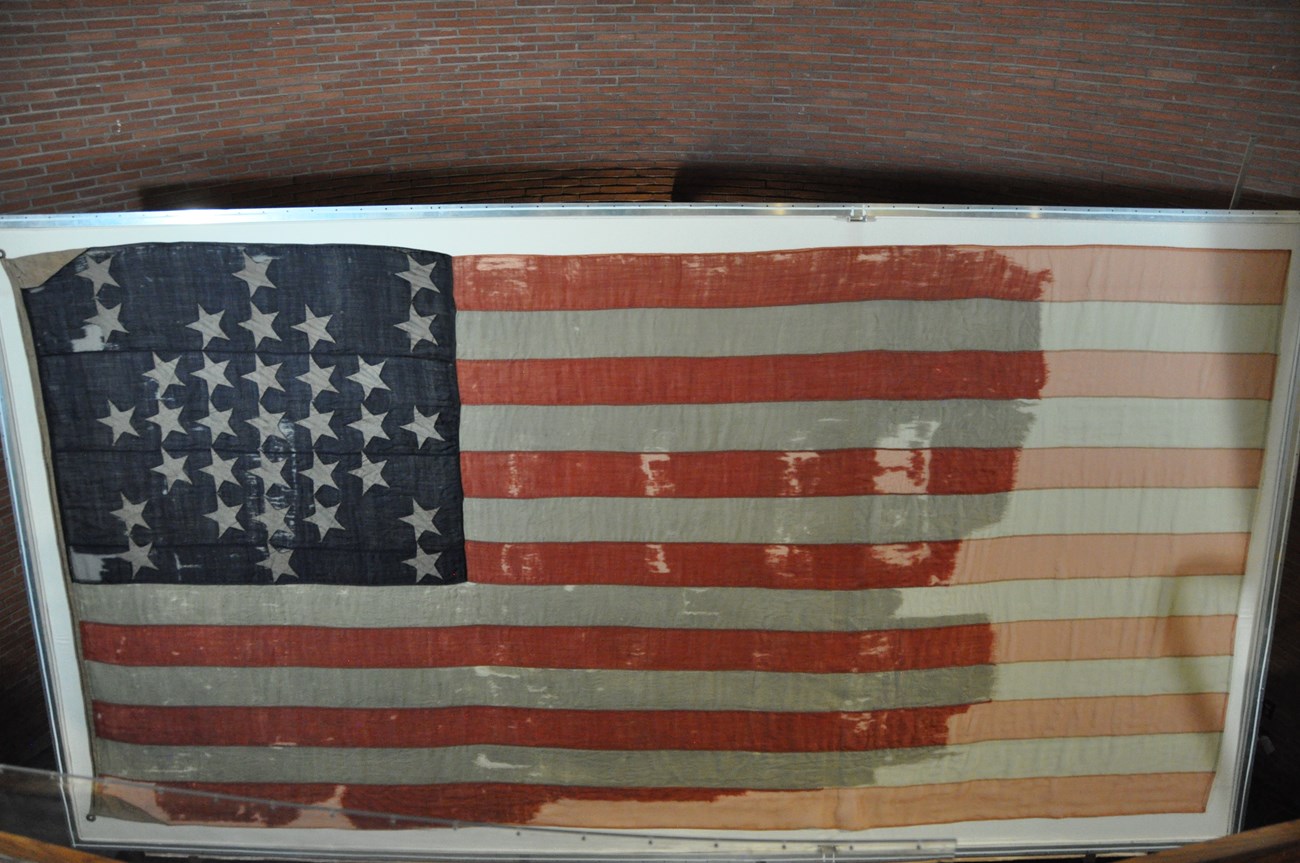Last updated: April 1, 2025
Article
The Fort Sumter "Storm Flag"

NPS/M. Buchanan
Origins
The official flag of the United States between July 4, 1859 and July 3, 1861 had 33 stars. In January 1861, a 34th state, Kansas, was added, but would not receive its star on the American flag until the 4th of July, which fell after the Civil War began. [1]
Not all 33-star flags look alike! The star pattern of the flag – here a diamond pattern – was not standardized until the 20th century.
At Fort Sumter
The storm flag was the smaller of two flags which US soldiers brought from Fort Moultrie to Fort Sumter on December 26, 1860. It measured 10 feet tall by 20 feet long – slightly longer than a similarly-sized flag would be today. The storm flag was intended to be used during bad weather and high winds, to preserve the larger, more fragile “garrison flag”.
For more than three months, the American flag that flew over Fort Sumter was the only US flag in Charleston Harbor. Every other harbor fort flew flags of secession, and pointed cannons at the US flag. At least once during the standoff, locals took the lowering of the garrison flag to be a sign that the US soldiers were abandoning the fort – only to see the storm flag raised in its place to withstand the wind. [2]
At 4:30 AM on April 12, 1861, Confederates fired a signal shot over Fort Sumter, beginning a 34-hour bombardment – the first battle of the Civil War. Throughout the battle, it was the storm flag that flew. A month after the battle, Anderson told a newspaper the story:
“They had two flags at the fort, a large garrison flag, which he [Major Robert Anderson] raised when he took up his quarters at Sumter, and a smaller one, called the storm flag; the former had a slight rip in it, ands when he was notified that in one hour the batteries would open upon him, he ordered the storm flag to be raised its stead. The flag was never at half mast as telegraphed. The enemy constantly fired at it, and the halyards were shot away, when it ran down a little, became entangled with the dissevered ropes, and fixed so that it could neither be pulled down or hoisted up – virtually nailed to the mast.” [3]
After being forced to evacuate Fort Sumter, US soldiers brought the flag with them to New York City, where it was visible during a public rally in Union Square on April 20th, 1861. [4] Major Anderson kept the flag in his possession throughout the war – but it would see the light of day again.
Return to Fort Sumter
After almost four years of Confederate occupation of Fort Sumter, US forces regained possession of the fort, and the city of Charleston, on February 17, 1865. To commemorate the recapture of the site where the Civil War began, President Abraham Lincoln ordered a public ceremony on April 14:
“Ordered, first. That at the hour of noon on the 14th day of April, 1865, Brevet Major-General Anderson will raise and plant upon the ruins of Fort Sumter, in Charleston Harbor, the same United States flag which floated over the battlements of that fort during the rebel assault…” [5]
The ceremony would recognize the changes, at the fort and across the country, during the war. Attendees included:
- Matthias Harris – a US chaplain present at the beginning of the war
- Quincy Gillmore – a US general who had commanded an artillery bombardment of Fort Sumter, largely demolishing it
- John Nicolay – aide to President Lincoln
- William Lloyd Garrison and Henry Ward Beecher – abolitionist ministers commemorating the end of slavery in Charleston
- Robert Smalls – a man who had escaped from slavery by sailing a Confederate vessel past Fort Sumter in 1862 [6]
“1. That these United States shall be one and indivisible.
2. That States are not absolute sovereigns, and have no right to dismember the republic.
3. That universal liberty is indispensable to Republican Government, and that slavery shall be utterly and forever abolished!” [7]
The flag raising was intended to attract publicity and provide a symbolic endpoint to the war. However, it was overshadowed by the assassination of President Lincoln that night at Ford’s Theatre in Washington, DC.
The Storm Flag Today
The flag remained in Anderson’s family until 1905, when it was given to the United States War Department. When Fort Sumter was turned over to the National Park Service in 1948, the flag came with it.
The flag was on display in the Fort Sumter museum from 1985 until 2023. Currently, it is in the park’s museum collections, resting from light exposure. Light can damage the fabric of historic flags, and the NPS seeks to preserve the flag for future generations to see and understand it. They, too, should be able to appreciate how this flag changed its country.
Citations:
[1]: “History of the United States Flag.” National Republican, 1861 July 4, p. 1. Accessed via newspapers.com: https://www.newspapers.com/image/80557782/
[2]: “Our Charleston Letters.” The Philadelphia Inquirer, 1861 Mar. 28, p. 4. Accessed via newspapers.com: https://www.newspapers.com/image/167541391/
[3]: “Robert Anderson: The Heroic Defender of Fort Sumter.” St. Joseph Valley Register, 1861 May 16, p. 2. Accessed via newspapers.com: https://www.newspapers.com/image/1063827516/
[4]: “The Heroes of Fort Sumter.” The New York Times, 1861 Apr. 19. Accessed via newspapers.com: https://www.newspapers.com/image/20452169/
[5]: “General Orders, No. 50.” Stanton, Edwin M., 1865 Mar 27. Accessed via ucsb.edu: https://www.presidency.ucsb.edu/documents/executive-order-ordering-the-raising-the-flag-and-other-commemorations-fort-sumter
[6]: “Fort Sumter: Restoration of the Stars and Stripes.” The New York Times, 1865 Apr. 18. Accessed via nytimes.com: https://www.nytimes.com/1865/04/18/archives/fort-sumter-restoration-of-the-stars-and-stripes-solemn-and.html
[7]: “Fort Sumter: The Raising of the ‘Old Flag’ by Major Anderson.” The Charleston Courier, 1865 Apr. 15, pp. 1-3. Accessed via newspapers.com: https://www.newspapers.com/image/605574954/
